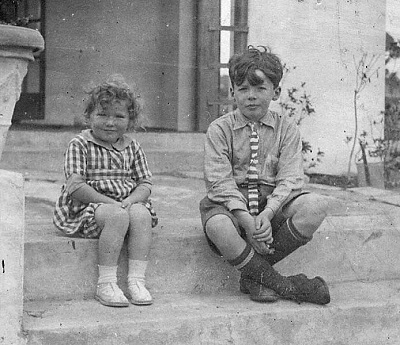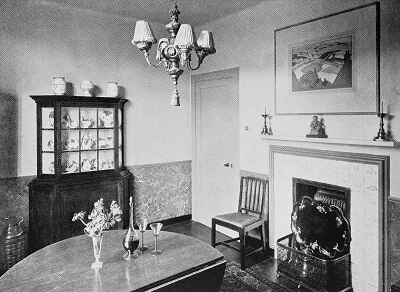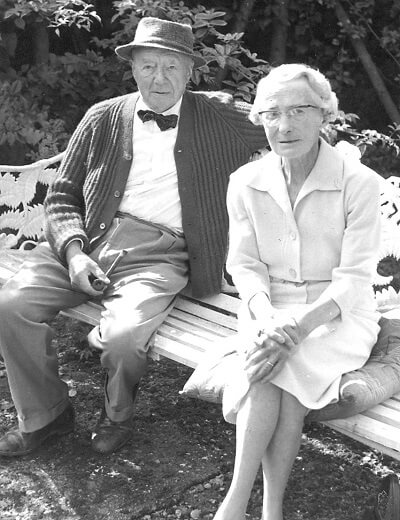White Steading, another example of innovative architecture in Amersham
by Alison Bailey March 2021
New materials
The early interwar years were a time of innovation for housebuilders who, forced by shortages in traditional materials, looked to new technology and pioneering methods of construction. Concrete is ubiquitous today, but in 1920’s Amersham it was unusual and modern. The Art Deco Regent Cinema would not have been possible without reinforced concrete, nor would the bold, geometric design of High & Over. However, earlier post-war houses, such as Harold Kennard’s development at Elm Close were also built with this new material. Another groundbreaking concrete house is White Steading, on Station Road.
White Steading
In 1921, the architect, Robert Lowry was commissioned to build a modern house between the old town and Amersham-on-the-Hill. On rising land, close to the station, the house was positioned to take advantage of the magnificent views of the Misbourne Valley and the town below.
The house and its interior were described in a Country Life article in 1924: “careful study has been given to its general mass and the proportion of its parts but it has eschewed the various trappings which are part of the orthodox architectural equipment. Thus window openings are quite plain with just a sill to carry off the water; and the chimneys are kept free of any embellishments. All this is a perfectly logical direct treatment with the form of construction adopted and thereby the house gains definitive character. The walling is in two skins of 4” concrete, built solid between shuttering, with a 3” cavity, the exterior being finished with cement, lime-whitened; in effective contrast with which are the wooden casements, painted blue. The floors also are of concrete, reinforced with expanded metal; the roof, of pleasing low pitch, being covered with Roman tiles”.

The Client

Lowry’s clients were Francis Rowland Yerbury, his wife, Winifred (née Bendall), a pianist, and their two young children, John and Greta. The family was living in Hampstead Garden Suburb and had a weekend cottage at Coleshill. Yerbury, who was passionate about architecture and design, seized the opportunity to build a modern country house in commuting distance of London. Born in Cricklewood in 1885, his dream of becoming an architect ended when he had to leave school at the age of 13 to help support his widowed mother and siblings. In 1901 he became the office boy at the Architectural Association School of Architecture (AA) in Tufton Street, Westminster, working his way up to the position of Secretary which he held from 1912 until 1937. During this time, he helped establish the school as a leading centre for architectural education, discussion, and debate.

A gifted photographer, Yerbury travelled extensively throughout the United States and Europe, documenting modern architecture. He also visited revolutionary Russia as a guest of the Union of Soviet Architects. His photographs of buildings were published in numerous books and a prolific number of articles. Yerbury’s photographs introduced architecture students to the works of many continental architects. His photographs of Le Corbusier’s work are the first published in Britain.
In the early 20s Yerbury provided a collection of photographs reflecting modern housing design, mostly in Britain, for a book Small Houses for the Community. In the foreword he was described as having “intimate knowledge of the best work that is being done today, and one of the best photographic exponents of architecture we possess”. Later books included Modern European Buildings (1928), and Small Modern English Houses (1929).
Yerbury’s ambition was to make the AA School the centre, both social and artistic, of the architectural world and his parties were legendary. During the annual student trips to Europe, his stamina often amazed the younger students: “His cheerfulness at 8 o’clock in the morning after a late night, and his peculiar knowledge of the nightclubs of Europe, were always of the greatest help. I would like to suggest a new name for him – Cerberus – a dog with several heads who never slept” reported Graham Tubbs after a visit to Vienna in 1931.
The Architect

As the architect for White Steading, Yerbury chose his colleague Robert Lowry. Lowry trained at the AA School before establishing his own practice in Richmond. He became Deputy Principal of the AA School and lectured in Greek, Roman and Renaissance architecture. He was awarded Associate membership of RIBA in 1916, and Fellow membership in 1925. In addition to White Steading, he designed several London houses, and Forest Lodge in Nottinghamshire for Francis Egerton Pegler. Forest Lodge is Grade II Listed.
The Interior

According to the Country Life article on White Steading “the interior is as individual as it is captivating”: “The walls are papered and coloured with an apricot tone; the ceiling, divided up into three bays by beams, is overspread with silvered paper which is brought down as a shallow frieze and finished with a border having a Greek fret in black on a gilt ground; while the floor is laid with wood blocks with a blue stain. Three long windows light this room from the south, and there is an end window opening into the garden room which is an attractive feature of the house. The dining room is finished with an ivory tone on walls and ceiling, and has a marbled paper dado representing lapis lazuli [a deep blue semi-precious stone], the doors being painted primrose. The hall has primrose walls and there is a further use of a marbled paper dado up the staircase”.

The Family

The decision to educate the children as day pupils at St Paul’s may have precipitated a move back to London in 1929. The family moved to 33 Bedford Place, close to Yerbury’s work at the AA which had moved to its current premises in Bedford Square in 1917. White Steading was sold, but from 1929 until 1935 they also kept a weekend cottage at Mop End, near the Griffin. Their daughter, Greta, later married Eric Janes (FRIBA) an architect, who had worked for Sir Edwin Lutyens before WWII. They met at the Wycombe Fireman’s Ball and married at High Wycombe Parish Church. During WWII Eric joined his father’s furniture firm Nicholls and Janes, later returning to architecture. In 1951 the family settled at Peterley Manor with Greta’s parents living next door at West Peterley Manor from 1951.

Frank and Win Yerbury celebrated their Golden Wedding Anniversary in 1963. He had been awarded OBE, Honorary Associate of RIBA and had received honours from the Kings of Denmark and Sweden in recognition of his contributions to international understanding of Scandinavian design. During WWII Yerbury travelled to Sweden in the bomb bay of a Mosquito aircraft on an official mission to reassure his architect friends about the state of British morale! Yerbury’s collection of over 3,000 negatives of architectural photography is the most valuable historical archive in the AA’s Photo Library and is still a valued resource for students today.
Sources
Rowland Janes
Frank Yerbury: Itinerant Cameraman. Architectural Photographs 1920-35 Published by the Architectural Association 1987 ISBN 0904503747
Frank Yerbury and the Search for the New by Andrew Higgott
Architectural Association School of Architecture Photo Library
Oxford Dictionary of National Biography
Country Life, The Lesser Country Houses of Today, White Steading, Amersham, July 12, 1924
British Newspaper Archive

